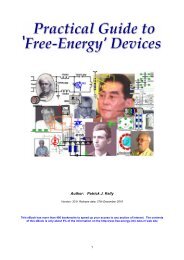Gallery of Clean Energy Inventions Exhibit - with setup details
The Gallery of Clean Energy Inventions Exhibit exhibits 45 generators, 23 advanced self-powered electric vehicle innovations, 27 radioactivity neutralization methods, 25 space travel innovations, 20 technical solutions to water shortages, and a torsion field school network. The exhibit also includes 26 movie posters and 98 fantastically colorful Hubble Space Telescope images. The exhibit can be installed in conventions, festivals, and any suitable public buildings such as universities, city halls, museums, shopping malls, and libraries.
The Gallery of Clean Energy Inventions Exhibit exhibits 45 generators, 23 advanced self-powered electric vehicle innovations, 27 radioactivity neutralization methods, 25 space travel innovations, 20 technical solutions to water shortages, and a torsion field school network. The exhibit also includes 26 movie posters and 98 fantastically colorful Hubble Space Telescope images. The exhibit can be installed in conventions, festivals, and any suitable public buildings such as universities, city halls, museums, shopping malls, and libraries.
Create successful ePaper yourself
Turn your PDF publications into a flip-book with our unique Google optimized e-Paper software.
Alpha radiation is one <strong>of</strong> four major types <strong>of</strong> radiation emitted by radioactive atoms. It<br />
is also referred to as ‘alpha particles’, or a ‘helium nucleus’. Other types <strong>of</strong> radiation<br />
are beta radiation, gamma radiation and neutrons.<br />
Of alpha, beta and gamma radiation, alpha radiation is by far the most dangerous if<br />
found inside the human body. That’s because unlike beta or gamma radiation, alpha<br />
radiation is easily absorbed by cells, where it can cause serious damage, including to<br />
DNA. Alpha particles can enter the body if they contaminate food or water, or if they<br />
are breathed in – hence the concern among both nuclear laboratories and Los Angeles<br />
county about airborne levels <strong>of</strong> alpha radiation.<br />
The alpha radiation detected from the Fukushima disaster most likely comes from<br />
plutonium 239, which is produced as a byproduct in many nuclear reactors. No alpha<br />
radiation, however, is emitted by cesium-137, which is probably the most prolific<br />
isotope emitted by Fukushima that is still circulating in the environment. Iodine-131,<br />
also emitted in large quantities, has a very short half-life and has probably mostly<br />
vanished from the environment by now.<br />
But whereas the beta and gamma radiation emitted by radioactive cesium may not be<br />
as dangerous from <strong>with</strong>in the body, it is actually far more dangerous if found outside<br />
the body – for example, in the contaminated water and soil around the Fukushima<br />
plant, or the contaminated water being dumped into the Pacific Ocean. That’s because<br />
beta and gamma radiation are far more able to penetrate the body’s external defenses,<br />
and tear apart cells and DNA as they pass through.<br />
ABOUT THE AUTHOR:David Gutierrez, is a staff writer for NaturalNews.com<br />
- See more at: http://www.healthnutnews.com/serious-meltdown-is-underway-thefukushima-daiichi-plant-no-2-nuclear-reactor-fuel-is-missing/#sthash.cTJILi9S.dpuf<br />
Comment: March 22, 2011 Melbourne, Florida was dosed <strong>with</strong> the highest level <strong>of</strong><br />
radioactive iodine-131 anywhere in the world<br />
Analysis <strong>of</strong> data from sensitive U.S. monitoring stations for the Fukushima Dai-ichi<br />
nuclear reactor accident, Journal <strong>of</strong> Environmental Radioactivity: [A] major nuclear<br />
event at the Fukushima Dai-ichi nuclear power station… resulted in a breach <strong>of</strong> the<br />
nuclear fuel integrity and release <strong>of</strong> radioactive fission products to the environment.<br />
Fission products started to arrive in the United States via atmospheric transport on<br />
March 15, 2011… Atmospheric activity concentrations <strong>of</strong> iodine-131 reached levels<br />
<strong>of</strong> 3 x 10^- 2 Bq/m ³ [30,592 microBq/m³] in Melbourne, FL. The radioactive noble gas<br />
xenon-133 reached atmospheric activity concentrations in Ashland, KS <strong>of</strong> 17 Bq/m³…<br />
[These levels] were well above the detection capability <strong>of</strong> the radionuclide monitoring<br />
systems <strong>with</strong>in the International Monitoring System [IMS] <strong>of</strong> the Comprehensive<br />
Nuclear-Test-Ban Treaty [CTBTO]… it should be noted that non-IMS stations located<br />
in Richland, WA detected the event one day earlier than any other systems <strong>with</strong>in the
















